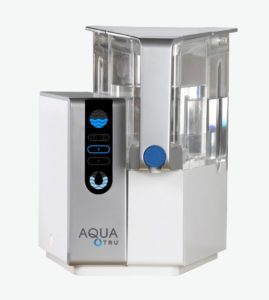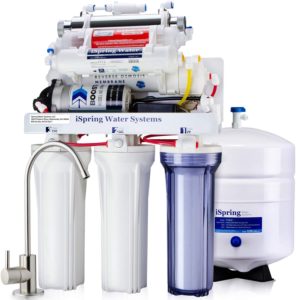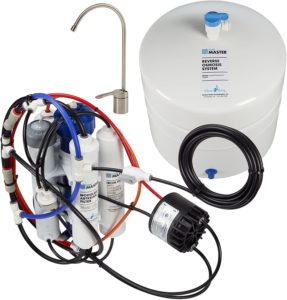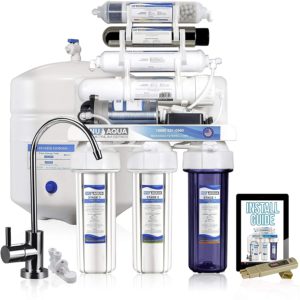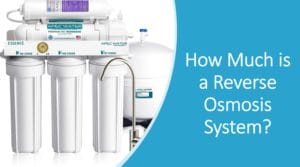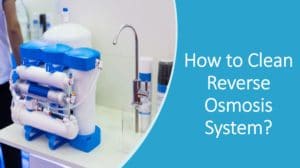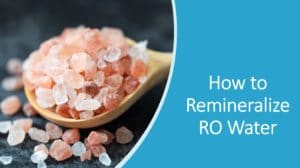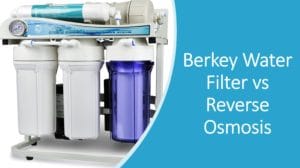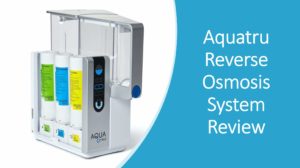Are you considering reverse osmosis for well water? We have a few recommendations that will ensure you have a constant supply of healthy, safe drinking water for you and your family.
We understand that the market today is saturated. We are here to help you find the ideal at-home reverse osmosis solution. The resulting list highlights only five RO systems for well water after researching, reading up on reviews, and even contacting manufacturers.
Best RO Systems for Well Water
1. Waterdrop Reverse Osmosis Water Filter System G3
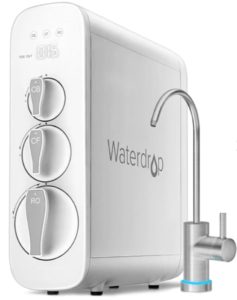
Waterdrop G3 is the strongest contender for the top reverse osmosis system for well water title. The seven filtration stages include a sediment pre-filter with three stages, an RO filter containing three stages, and a final carbon filter stage. It boasts a 0.0001um filtration accuracy, eliminating 99% of well water contaminants such as heavy metals, TDS, fluoride, and limescale.
Many under sink systems have a pressurized storage tank. This Waterdrop has a tankless design, which prevents secondary pollution while saving space under the sink. The internal permeate pump produces an impressive 400 gallons of water daily – which is over five times the normal capacity of similar units.
1:1 gallons of wastewater produced compared to well water makes the Waterdrop G3 one of the most efficient systems on the market. The RO filter in the unit lasts 24 months, the activated carbon filter 12 months, and the carbon filter 6 months. An easy twist-and-pull design means replacement takes a few seconds without turning off your water supply.
Technology features include a holiday mode that turns the G3 runs an automatic flush if we do not use it for 24 hours. The smart TDS LCD panel shows the real-time quality of drinking water and TDS contents, while an overworked reminder turns the unit off after dispensing water for 30 minutes.
Waterdrop G3 delivery is partly assembled and allows DIY installation in less than 45 minutes. The included user manual has instructions on how to connect the unit to the electricity supply and faucet. You can also connect it to an ice maker or a refrigerator, but you’ll need to buy extra tubing for attaching the device.
- A tankless filtration system
- Low drain ratio
- A compact design that saves space under the sink
- Filters out 94% of TDS and other contaminants in water
- 400 gallons of water output daily
- Ability to show real-time water quality
- Easy to install and maintain
- NSF/ANSI 58 certified
- No water remineralization feature
- Does not work longer than 30 minutes because of the smart system
- Cannot place the unit on its side
- Pricey
2. AquaTru Reverse Osmosis Water System
Our second choice for the best RO systems for well water is this AquaTru countertop style unit. This four-stage filtration unit has two pre-filters for removing larger particles like silt, sediments, and sand from well water. An RO filter stage can remove particles larger than 0.00001 microns, and a VOC carbon filter helps get rid of organic compounds in drinking water.
You can store the unit on the kitchen counter to provide pure, clean drinking water at the touch of a button. AquaTru diverts contaminated water into a wastewater tank, which allows easy removal once it’s full. The purified water storage tank takes up to 15 minutes to fill and can hold a gallon of clean water at a go.
AquaTru wastes only about 25% of water during the reverse osmosis process, making it one of the more efficient units on the market. Stage one and two pre-filters and stage four VOC filters last about six months before requiring replacement, while the VOC filter lasts 24 months. A side panel offers a hassle-free filter replacement experience.
A control panel on the AquaTru shows when each filter is working and its condition. This means no more guesswork when trying to find out the efficacy of the filters. An easy dispensing button makes pouring pure water into a glass effortless and without touching a messy lever handle or twist knob.
All filters come inside one body, so you don’t need to put them together once you receive your AquaTru. You require no installation before using the unit, which makes the set-up significantly faster compared to installing under sink RO systems. Switch the machine on, and it’s ready to use with the touch of a button.
- A great space-saving countertop design
- Simple installation
- A 4:1 drain ratio that is less than many standard RO systems
- Long-lasting filters
- One-year warranty
- NSF-certified for removing 82 contaminants
- Small one-gallon holding tank
- Fewer well water filtration stages compared to other RO systems
- No remineralizing filter
3. iSpring RCC1UP-AK
The iSpring RCC1UP-AK is our #3 pick because it eliminates 99% of 1,000 impurities in water. A unique 7-stage filtration system includes ultraviolet sterilization to remove microorganisms that make it past the RO filter. An additional alkaline remineralization filter restores minerals to your water, so it tastes natural.
This model comes with a clean water storage tank that holds three gallons of water at a time before passing it through a lead-free brass body faucet for drinking. An included booster pump brings water pressure to the desired level to ensure optimum RO. The pump allows the system to produce water faster while reducing wasted water.
The RCC1UP-AK produces water at a 1:1 ratio, so you lose a gallon of water for every gallon produced. iSpring recommends changing the pre-filters every six to 12 months, RO membrane after two to three years, alkaline remineralization and GAC filters after 12 months, and the UV lamp at least every one to three years.
The reinforced first stage housing is transparent, so you can inspect the sediment filter and watch as it removes contaminants. A flow switch connected to the faucet activates 11 UV lights in the flow chamber, so any microorganisms in the water passing through the filter are removed. It also comes with a beautifully crafted faucet mountable on a kitchen counter.
The iSpring RCC1UP-AK is advertised as DIY, but it can be complex for homeowners with basic skills. Filters, the booster pump, and other components are built into the unit’s main body, reducing the number of installation tasks you carry out. The unit arrives with an additional cleaning and maintenance manual and lifetime technical support.
- A 75-gallon per day capacity
- Built-in booster pump
- Built-in UV light
- Alkaline remineralization water filter
- A sensor that turns off UV-bulb when not in use
- One year with lifetime technical support
- NSF/ANSI certified
- Might be a tight fit if your kitchen sink has a garbage disposal
- Installation requires following several installation videos carefully
- There’s no option to remove the remineralizing filter
4. Home Master TMHP HydroPerfection
The Home Master TMHP HydroPerfection RO system sends water through nine filtration stages, which include iron, alkaline remineralizing, and modular sediment filters. Home Master claims the unit can remove up to 99% of VOC. A UV light filter helps eliminate living organisms, bacteria, and viruses found in well water.
A storage tank in the system can hold up to 3.2 gallons of clean water and is refilled automatically when filtered water is used. A long-reach sink prevents contaminants from being added to your water from the tank to the drinking glass. The included non-electric permeate pump increases the system’s output to 75 gallons a day.
The reverse osmosis system for well water uses the permeable pump to produce water at a 1:1 waste to production rate. The wastewater amount may vary depending on the pressure of water entering the Home Master HydroPerfection. However, the permeate pump also helps the system improve pressure while increasing efficiency.
This Home Master model includes high flow features that help increase the fill rate at the faucet called Fast Flow RO. The technology includes larger fittings and tubing, which work with the permeate pump to produce a faster output. The resulting flow is about eight ounces every 5 seconds, which is fast compared to other options.
Anyone with rudimentary DIY skills can install the Home Master TMHP HydroPerfection. A full set of installation instructions, the owner’s manual, and a series of videos show how to install the unit. The package also comes with a fridge connection kit, a brushed nickel pure water faucet, and a water tank.
- Designed to take care of microorganisms and iron, among other contaminants, in well water
- The remineralizing filter adds magnesium and calcium back to filtered water
- Permeate pump included
- Long-lasting filters
- A 5-year limited manufacturer’s warranty
- Modular filters allow replacement without tools and prevent flooding
- Pricier than most units
- Requires a 110-volt outlet for the UV light
- Storage tank might be a tight fit if you have a disposal
5. NU Aqua Platinum Series 7-Stage
NU Aqua Platinum Series 7-stage system brings you the basic sediment, carbon GAC, carbon block, membrane, and post-filters. An additional ultraviolet filter eliminates E. coli, fungi, and other microorganisms found in well water. The final alkaline remineralization filter adds beneficial minerals into your water.
This NU Aqua RO model has a high 100-gallon a day capacity to cater to a large family. The included booster pump helps bring your water pressure to optimal levels. Homes without low water pressure issues will still benefit from the pump as it ensures faster and more efficient water production.
The booster pump also improves the system’s efficiency to a 2:1 ratio of wastewater to filtered water. Pre-carbon, carbon, sediment, and carbon polishing filters require changing every 12 months. The RO membrane brings you a slightly longer lifespan of about one to three years, depending on water usage.
NU Aqua comes with a bonus PPM meter, which is useful for measuring the level of dissolved solids in water and checking if filters are working efficiently. Integrated HydraCoil technology increases the absorption rate of filters for 50% cleaner water compared to other systems. An added flow restrictor helps prevent the backflow of water through the RO membrane.
Quick connect fittings and color-coded tubing ensure a painless and quick at-home installation. The NU Aqua Platinum Series 7-stage reverse osmosis system also comes with an installation video with step-by-step instructions if you prefer visual support. A compact design allows fitting the unit easily in a standard kitchen sink space.
- Alkaline and UV filters
- A built-in flow restrictor
- Bonus PPM meter
- High 100-gallon per day flow rate
- Comprehensive installation instructions
- HydraCoil technology supports water filtration
- NSF-approved RO storage tank
- Installation is more complex compared to other units on this list
- Does not function well with water pressures below 45 psi
How We Picked Well Water Reverse Osmosis System
To be considered in this guide, we looked at the following factors in each reverse osmosis system.
Type of Reverse Osmosis System
Our research reveals that there are two common types of RO systems for a home kitchen, these are:
Countertop Systems
Designed to sit on the ground or countertop, these units are usually compact, so there’s no sacrificing too much counter space or worrying about a complicated installation process. Countertop RO systems are suitable for renters or anyone who doesn’t want to make permanent changes.
Under-counter Systems
Under-sink reverse osmosis systems are the most common option we came across. They are easy to use since all you need to do is turn on a faucet running well water. Installation, however, might be complicated and requires calling in a professional.
The Contaminants Removed
Reverse osmosis systems reduce the number of contaminants in your water, including:
- Protozoa, viruses, and bacteria
- Total dissolved solids (TDS) such as potassium, calcium, lead, and copper
- Common metal ions and aqueous salts such as arsenic, chromium, nitrate, sulfate, and chromium
- Organic chemicals with a molecular weight greater than 200
The fundamental difference between RO systems is the percent of contaminants they filter out. Most remove about 95% to 98% of contaminants. Other systems have carbon pre and post-filters to filter out more impurities, including volatile organic compounds (VOCs) in well water.
Flow and Wastewater Rates
Water filters impact flow rate, but RO systems slow it down the most because of a high level of filtration. A low flow rate is a common customer review complaint against RO units.
RO systems generate wastewater. They wash away contaminants behind the membrane using more water.
The average reverse osmosis system will generate four gallons of wastewater for every one gallon of well water. We expect the best systems to maximize flow while reducing wastewater.
Durability
Many RO systems should last about 10 to 15 years and filter cartridges about 12 to 24 months. Systems with carbon filters can last between 6 to 12 months. Like everything else we purchase, a cheap reverse osmosis system with poor-quality parts will have a shorter lifespan.
Another critical consideration was the ease of installation of the replacement filters. Most of the systems on this list have easily accessible filters. This makes it easy to swap out a filter.
Presence of a Permeate Pump
Permeate is the filtered water from an RO system. A permeate pump pushes this water into a storage tank. This system ensures you have more pure water and less wastewater.
Pumping permeate creates less pressure at the RO filter because of less water buildup on the permeate side. This way, the system moves water across the membrane faster and more efficiently. The result is a reduced need for wastewater, and the membrane removes contaminants more effectively.
Remineralization
RO filtration can sometimes be too good. The process removes TDS, including minerals such as magnesium, calcium, and sodium. However, pure RO and demineralized water carry some risks and adverse effects, according to this WHO report.
Removing too much TDS from well water also makes the water less tasty and acidic. We prefer RO systems with remineralization to introduce some of the TDS back into the water. This helps improve water drinking and cooking experiences.
Certifications
The National Science Foundation (NSF) and Water Quality Association (WQA) certify water filters. RO systems require an extra set of certifications that include the NSF 58 standard. Third-party certification provides added assurance that the RO system will do what it claims.
Frequently Asked Questions
RO systems for well water are efficient at removing impurities and contaminants from your water. They have proven effective at removing everything from E. Coli to cryptosporidium and other contaminants like lead.
Yes, reverse osmosis systems remove total dissolved solids (TDS) and inorganic minerals from most city water and well water. The RO membrane separates these dissolved salts or solids and flushes them down the drain.
Yes. Filters in reverse osmosis systems do an excellent job of removing these and more contaminants, including fuel additives, herbicides, and biological threats like viruses.
The cost to hire a plumber to install the system is usually between $100 and $350.
Conclusion
After completing thorough research, we conclude that the Waterdrop G3 RO is the best all-around reverse osmosis system for well water. It combines technology, easy installation, and a compact size with a thorough 7-stage filtration that gives you the healthiest, purest drinking water.
We have covered the best reverse osmosis for well water solutions on the market. We hope our many research hours, exclusive ranking factors, and comparisons help you find the right unit for your home.

